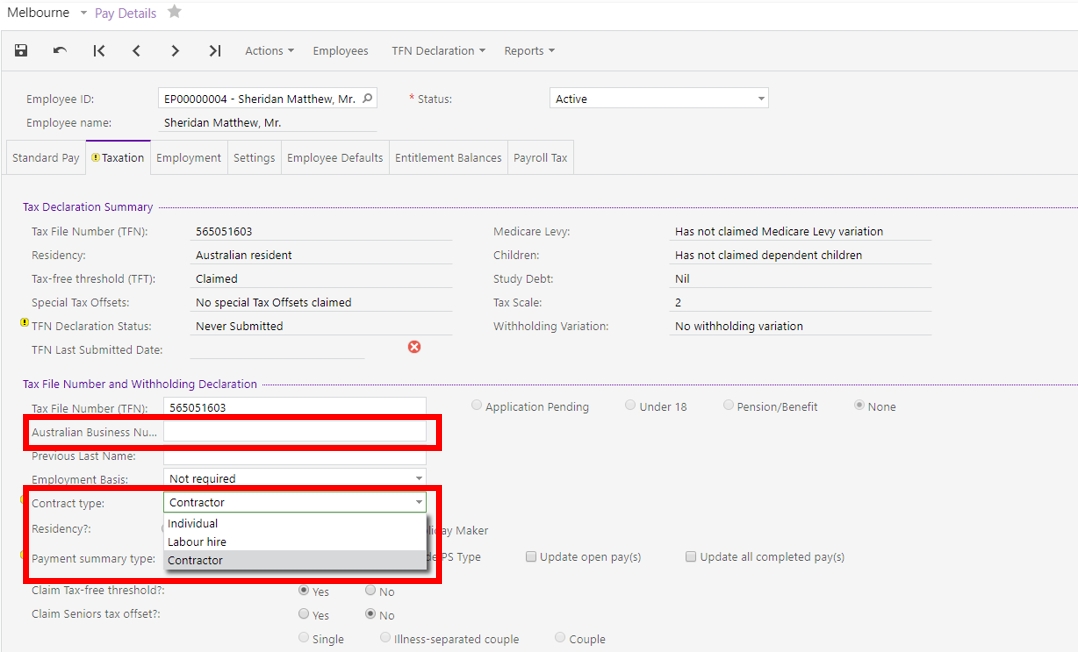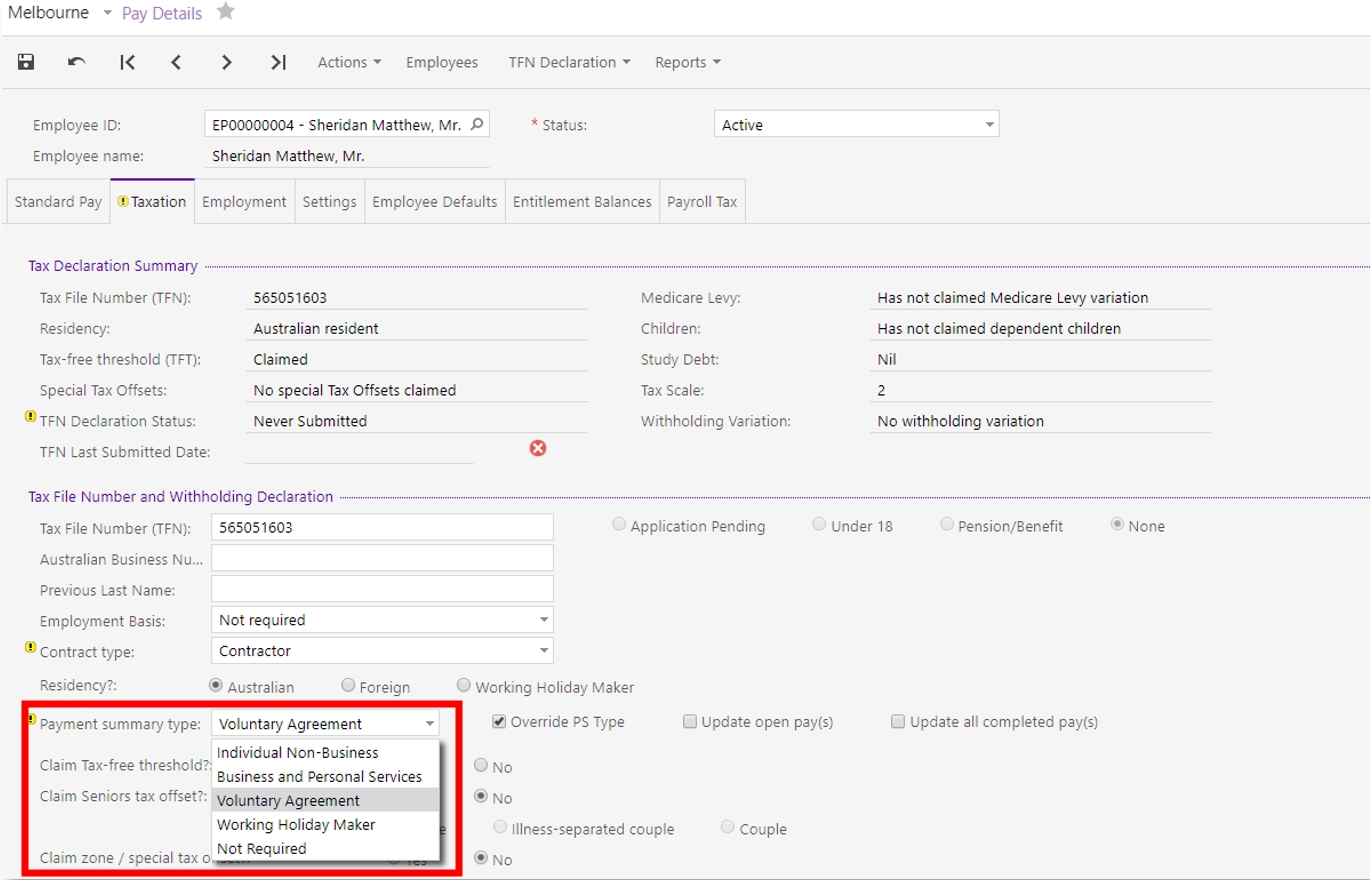Contractors
Managing contractors
Previously, MYOB Acumatica — Payroll only supported contractors as an option in the Employment Basis dropdown on the Taxation tab of the Pay Details form (MPPP2310). There was no explicit taxation treatment, and no payment summary types (which are used in STP reporting).
As of the 2018.1.4 release, the system provides more functionality to support contractors.
The taxation tab
When setting up employees, it is important to be clear on how the settings on the Taxation tab of the Pay Details form (MPPP2310) are used and how they relate to each other. The Taxation tab is used for three purposes:
The employee’s TFN declaration
Determining the employee’s taxation—the Contract type field (see New fields and options), along with the other questions on the Taxation tab, determines how the employee is taxed.
Determining the employee’s Payment Summary type—the Payment Summary Type field determines the type and therefore the category for Single Touch Payroll reporting. By default, this field is read-only and set automatically (see Payment summary type).
You can override the Payment Summary type, but take care when doing so—this can result in an invalid combination of settings.
Contractor types supported
Labour hire
Refer to the ATO’s definition of a labour hire firm.
“You operate a labour-hire firm if:
you arrange for workers to perform work or services directly for clients
the client pays you for this service
you pay the worker for the performed work or services provided to the client
the worker is not an employee of the client
you may or may not employ the worker.”
Key points:
You must withhold tax from individual workers under a labour-hire arrangement whether they are an employee or independent contractor.
Workers must supply their TFN, regardless of whether they also have an ABN or an instalment rate to vary the rate of tax.
Priority rules for withholding payments:
Payments for work or services (e.g. salary) take priority over payments under labour hire.
Employment termination payments (ETPs) take priority over payments under labour hire.
Payments under labour hire take priority over payments under voluntary agreement.
Payments to labour hire workers are reported to the ATO using the Business and Personal Services (BPS) payment summary type.
In summary, workers under labour hire must supply a TFN and must be taxed as an employee.
Voluntary agreement
Refer the ATO’s description of voluntary agreements.
Contractors are generally responsible for managing and paying their own taxation and superannuation, and have limited entitlements to paid leave.
A voluntary agreement is an agreement between a business (the Payer) and a contract worker (Payee) to bring work payments into the pay as you go (PAYG) withholding system. It can only be entered into if there is no obligation to withhold PAYG. Contractors under labour hire are excluded.
Taxation under a voluntary agreement is at a flat rate—either the worker will notify you of their ATO advised “Commissioner’s instalment rate” (CIR) or a flat rate of 20% will apply.
New fields and options
As of the 2018.1.4 release, the Labour hire / Contractor option has been changed to Labour hire in the Employment Basis dropdown on the Taxation tab of the Pay Details form (MPPP2310) and a new Contract type dropdown has been added. This dropdown’s available options are:
Individual
Labour hire
Contractor
The contractor’s ABN can now be saved in a new Australian Business Number field. This is enabled when either “Labour hire” (optional) or “Contractor” (mandatory) is selected.

Employment basis changes
The available options in the Employment Basis dropdown are now determined by the Contract type:
If the Contract Type is “Individual”, the Employment Basis dropdown includes only “Full-time” (default), “Part-time” and “Casual”.
If the Contract Type is “Labour hire”, the Employment Basis dropdown includes only “Labour hire” (default).
If the Contract Type is “Contractor”, the Employment Basis dropdown is set to “Not required” (default).
If an employee’s Contract Type selection changes, the Employment Basis selection will be changed to the default for the Contract Type selection, as above.
The Employment Basis dropdown on the Employment History tab of the Employees form (EP203000) has also been affected by this release: the Labour hire / Contractor option has been changed to Labour hire; however, this dropdown is not affected by the contract type (as the Contract Type setting exists on the Pay Details form only). The Employment Status dropdown on this tab also contains a new Contractor option.
Contractor taxation
When Contractor is selected, the employee must be taxed at the taxation rate for contractors—this is usually 20%, but the contractor may supply a different rate. To do this, you must ensure that the pay items in the employee’s pay are set to use a custom tax rate, with the contractor’s rate specified.
When the Contractor option is selected, a note appears on the Pay Details form (MPPP2310), reminding you to set up the employee’s taxation this way.
Payment summary type
On the Pay Details form (MPPP2310), the Payment Summary Type field has been moved from the Employment tab to the Taxation tab. There are several new types, and the appropriate one will be automatically selected based on the selections for residency and contractor. This can be overridden if necessary.
If residency is Australian, and contract type is “Individual”, then PS type is set to Individual Non-Business (INB).
If residency is Australian, and contract type is “Labour hire”, then PS type is set to Business and Personal Services (BPS).
If residency is Australian, and contract type is “Contractor”, then PS type is set to Voluntary Agreement (VA).
If residency is Foreign, then PS type is set to Individual Non-Business (INB).
If residency is Working Holiday Maker, then PS type is set to Working Holiday Maker (WHM).
The BPS and VA types are supported by Single Touch Payroll reporting only, i.e. you cannot report them using the PSAR.
The Working Holiday Maker type is a Payment Summary type for reporting purposes, but in practise it is actually the Individual Non-Business type, with WHM earnings reported separately. This applies to the PSAR and STP.

Payment summary amount breakdowns
Columns that break down the totals for each payment summary type are available on the Payment Details tab of the Manage STP Submissions form (MPPP5019). Click the Column Configuration icon on this tab ( ) to choose which of these columns you want to see.
